

OWL Web Ontology Language Current Status - W3C. This page summarizes the relationships among specifications, whether they are finished standards or drafts.

Below, each title links to the most recent version of a document. Completed Work W3C Recommendations have been reviewed by W3C Members, by software developers, and by other W3C groups and interested parties, and are endorsed by the Director as Web Standards. Learn more about the W3C Recommendation Track. Group Notes are not standards and do not have the same level of W3C endorsement.
Standards. OWL - Semantic Web Standards. Overview The W3C Web Ontology Language (OWL) is a Semantic Web language designed to represent rich and complex knowledge about things, groups of things, and relations between things.
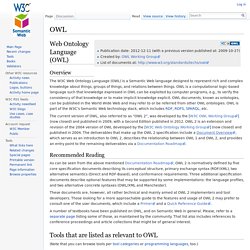
OWL is a computational logic-based language such that knowledge expressed in OWL can be exploited by computer programs, e.g., to verify the consistency of that knowledge or to make implicit knowledge explicit. The Common European Research Information Format (CERIF) Ontology Specification. This work is licensed under a Creative Commons Attribution-NoDerivs 3.0 Unported License.
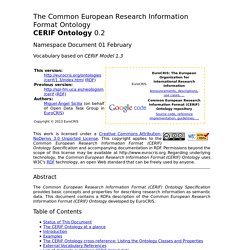
This copyright applies to the Common European Research Information Format (CERIF) Ontology Specification and accompanying documentation in RDF. Permissions beyond the scope of this license may be available at Regarding underlying technology, the Common European Research Information Format (CERIF) Ontology uses W3C's RDF technology, an open Web standard that can be freely used by anyone.
The Common European Research Information Format (CERIF) Ontology Specification provides basic concepts and properties for describing research information as semantic data. 03 LD.Publishing. An Overview of Open Source Tools for Patent Analytics – Open Source Patent Analytics – A work in progress home for the WIPO Open Source Patent Analytics Manual. This article provides an overview of the open source and free software tools that are available for patent analytics.
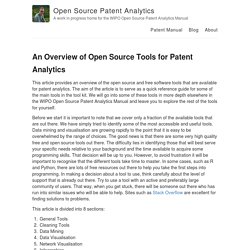
The aim of the article is to serve as a quick reference guide for some of the main tools in the tool kit. We will go into some of these tools in more depth elsewhere in the WIPO Open Source Patent Analytics Manual and leave you to explore the rest of the tools for yourself. Before we start it is important to note that we cover only a fraction of the available tools that are out there. We have simply tried to identify some of the most accessible and useful tools. In defence of OpenURL: making bibliographic metadata hackable. This is not a post I'd thought I'd write, because OpenURL is an awful spec.
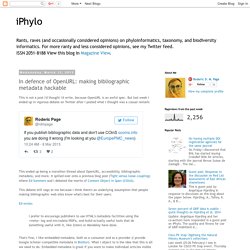
But last week I ended up in vigorous debate on Twitter after I posted what I thought was a casual remark: This ended up being a marathon thread about OpenURL, accessibility, bibliographic metadata, and more. NCompass Live: Metadata Manipulations: Using Marc Edit And Open Refine To Enhance Technical Services Workflows : Nebraska Library Commission. Enhancing Descriptive Metadata Records with Freely-Available APIs.
By Mark Phillips and Hannah Tarver Introduction The University of North Texas Libraries’ Digital Projects Unit (DPU) worked on two projects for The Portal to Texas History [1] that make use of publicly-available application programming interfaces (APIs) to enrich and extend metadata records so that more users are able to find the resources which the records describe.
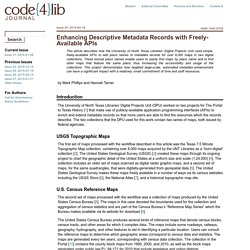
The two collections that the DPU used for this work contain two series of maps, both issued by federal agencies. USGS Topographic Maps The first set of maps processed with the workflow described in this article was the Texas 7.5 Minute Topographic Map collection, containing over 8,000 maps acquired by the UNT Libraries as a “born-digital” collection [2]. » A Librarian’s Guide to OpenRefine ACRL TechConnect Blog. Academic librarians working in technical roles may rarely see stacks of books, but they doubtless see messy digital data on a daily basis.
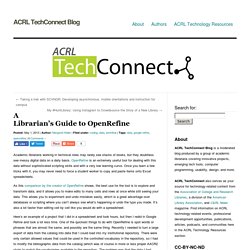
OpenRefine is an extremely useful tool for dealing with this data without sophisticated scripting skills and with a very low learning curve. Once you learn a few tricks with it, you may never need to force a student worker to copy and paste items onto Excel spreadsheets. As this comparison by the creator of OpenRefine shows, the best use for the tool is to explore and transform data, and it allows you to make edits to many cells and rows at once while still seeing your data. This allows you to experiment and undo mistakes easily, which is a great advantage over databases or scripting where you can’t always see what’s happening or undo the typo you made. How to Beat Bibliographic Data into Submission, pt. 1. Did you know that the Internet Archive (IA) has digitized out-of-copyright texts from some of the world’s most venerable universities and they are available to you for free to download?
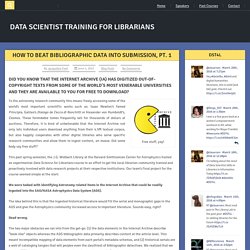
Free stuff, yay! To the astronomy research community this means freely accessing some of the world’s most important scientific works such as: Isaac Newton’s famed Principia, Galileo’s Dialogo de Cecco di Ronchitti or Alexander von Humboldt’s, Cosmos. These formidable tomes frequently sell for thousands of dollars at auctions. Therefore, it is kind of unbelievable that the Internet Archive not only lets individual users download anything from their 4.5M textual corpus, but also happily cooperates with other digital libraries who serve specific research communities and allow them to ingest content, en masse.
OpenRefine: A Tool for Print Collection Management. When I enrolled in the Fall, 2014 Data Scientist Training for Librarians (DST4L) course, I wasn’t sure how relevant the course’s content would be to my current projects.
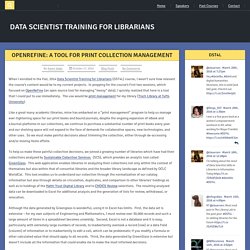
In prepping for the course’s first two sessions, which focused on OpenRefine (an open source tool for managing “messy” data), I quickly realized that here is a tool that I could put to use immediately. The use would be print management for my library (Tisch Library at Tufts University). Like a great many academic libraries, mine has embarked on a “print management” program to help us manage ever-tightening space for our print books and bound journals; despite the ongoing expansion of eBook and eJournal platforms in our collections, we continue to purchase a substantial number of print books every year and our shelving space will not expand in the face of demands for collaborative spaces, new technologies, and other uses.
Although the data generated by Greenglass is wonderful, using it in Excel has limits. How to Beat Bibliographic Data into Submission, pt. 2. How to Beat Bibliographic Data into Submission, pt. 1.